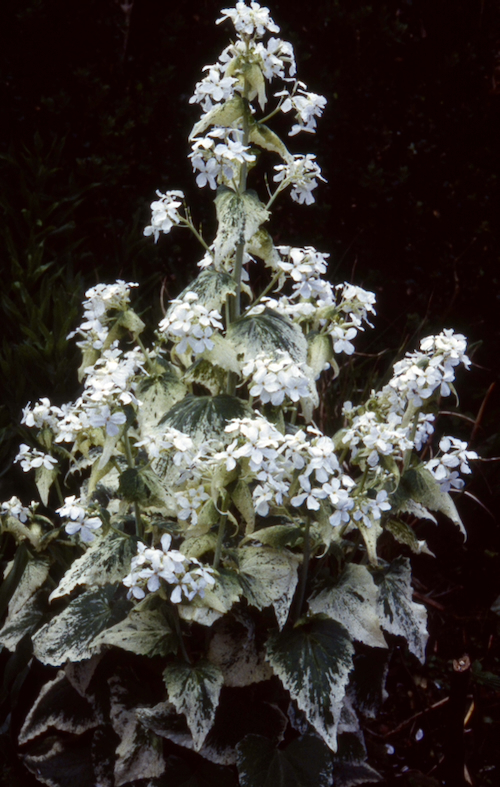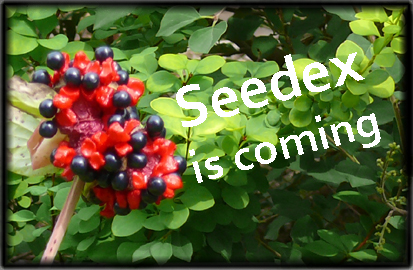
Plant of the Month February 2024
GENERAL INFORMATION: We had few coniferous trees in our gardens when I was growing up in England. I do not remember any pines, spruces, junipers or cypress. We had some yews - small ones were dug up for Christmas trees. We thought all these evergreens belonged in Churchyards!
Our garden evergreens were various hollies, laurels and box. What a lot we were missing!
Chamaecyparis or false cypress has a wealth of species and cultivars. Forest trees are used for traditional Japanese structures (I was able to ask a Japanese Shakespeare scholar if a theatre was made of Hinoke wood to answer a US scholar’s question!).
Many small cultivars are wonderful accents in our rock gardens and troughs.
Our Chamaecyparis obtusa ‘Nana Gracilis’ was planted in 1994. I have removed and thinned some side branches. We call it “The Lone Pine” after the Tom Thompson painting.
Common Name: Dwarf Hinoke cypress, dwarf Hinoke false cypress.
Cultivars: Many Chamaecyparis obtusa cultivars, varying in size, shape and colour.
Life Cycle: Dwarf coniferous tree.
Chamaecyparis obtusa 'Nana Gracilis' Aug '16. C. obtusa ‘Nana Gracilis' Oct '23.

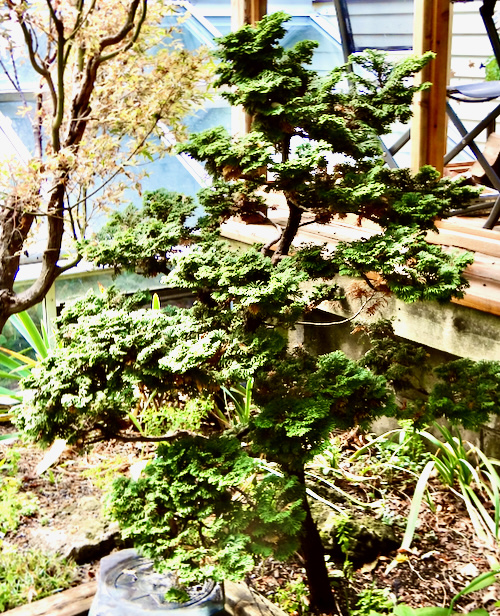
Flowers: Non-blooming. Reproduction by naked seeds in minute cones. The young female cones are green, becoming brownish red when mature. Male cones are more orange. My plant has not produced cones.
Height: 90-200 cm high, 60-120 cm wide after 10 years. My specimen is over 30 years old and is now about 110 cm high.
Chamaecyparis obtusa ‘Nana Gracilis' Jan '24.
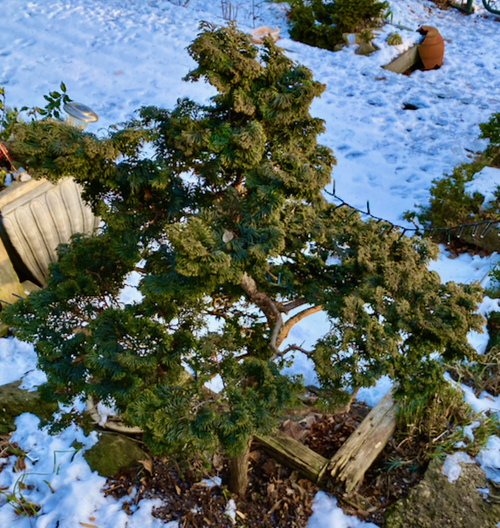
Bark: is reddish brown and will peel on older trees.
Leaves: Tiny green needles are like scales, up to 2 mm long, tightly packed forming shell like sprays at the ends of the branchlets. The colour is darker green in winter.
Chamaecyparis obtusa ‘Nana Gracilis' needles. Close up.
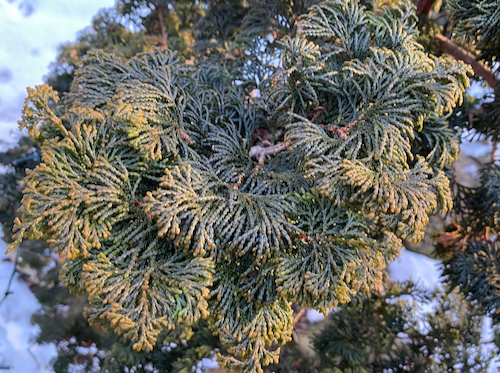

Range: Chamaecyparis obtusa is native to Central Japan.
Habitat: It grows on slopes in mixed coniferous forests.
CULTIVATION:
Low maintenance.
Light: Sun to partial shade.
Soil: All types of soil, preferring slightly acidic. Must be moist and well drained.
Water: Average.
USDA Hardiness: Zones 4-8.
Companion planting: Other rock garden plants or use as a specimen in the rock garden or in a trough.
Propagation: From semi hardwood cuttings or grafting.
Pruning: Not needed, unless to cloud prune.
Pests and diseases: Watch for aphids. Honey fungus and Phytophthora root diseases can occur but usually trouble free.
Native alternatives: Several Ontario or near Ontario native conifers have dwarf forms with interesting shapes. Look for cultivars of Juniperus virginiana, Pinus strobus, P. virginiana and Tsuga canadensis. (Pinus strobus ‘Angel Falls’, ‘Coney Island’ ‘Mini Twists’, Tsuga canadensis ‘Pendula’ etc.)
References:
https://www.missouribotanicalgarden.org/PlantFinder
https://www.gardenia.net/plant/chamaecyparis-obtusa-nana-gracilis
https://onrockgarden.com/index.php/germination-guide
Text and images supplied by Anna Leggatt (Toronto Master Gardener)

Plant of the Month January 2024
GENERAL INFORMATION:
Mahonias were not on my garden lists when I was young. “Oregon grape” was a poor substitute for holly in England. Our neighbour here in Canada had a bed filled with Mahonia aquifolium beside her front door, facing north and east. It was dull dark green all year with a bronzy tone in winter and a few yellow flowers in early spring. Garbage blew in and was difficult to remove. Our present neighbours axed it. However, I remember Thelma as it gave us a very attractive seedling in our front bed.
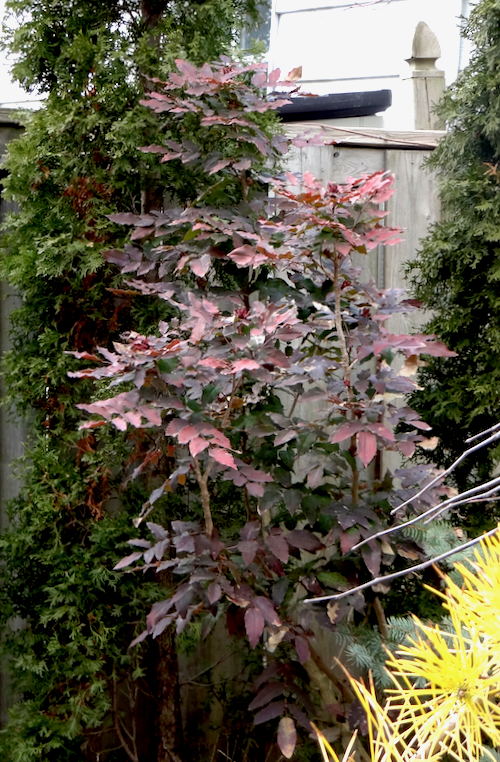
Mahonia x wagneri ‘Pinnacle'. Early March.
Mahonia x wagneri ‘Pinnacle' is a splendid hybrid between Mahonia aquifolium and Mahonia pinnata.
Synonym: Berberis aquifolium ‘Fascicularis', Mahonia pinnata 'Pinnacle' and Mahonia aquifolium ‘Fascicularis’.
Common Name: Oregon Grape ‘Pinnacle’, Oregon Holly Grape.
Other Cultivars: Mahonia aquifolium ‘Apollo’ is similar. Mahonia aquifolium ’Smaragd’ is shorter.
Life Cycle: Upright, evergreen shrub which may produce suckers.
Height: 1.5 m, slow growing.
Bloom Time: Late April, early May in Toronto.
Mahonia x wagneri ‘Pinnacle' - Flowers - Early May.
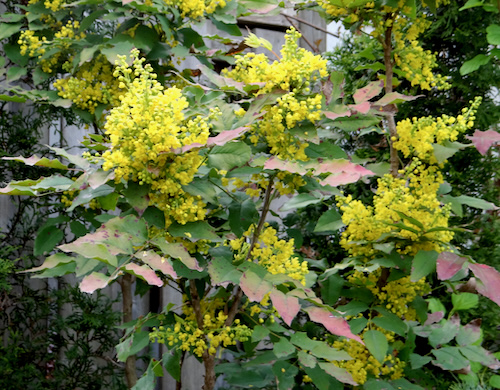
Flower Colour & Size: Tiny yellow flowers in dense racemes at branch tips before the new leaves appear. The flowers are up to 1 cm long and look like tiny daffodils.
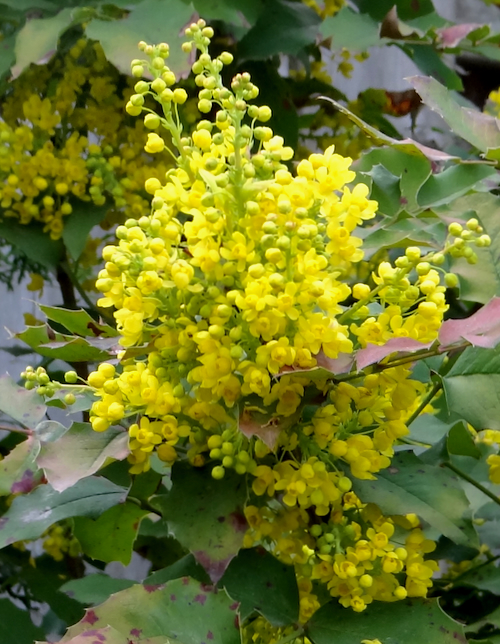
Mahonia x wagneri ‘Pinnacle' - close up.
Leaves: Compound leaves with 5-11 leaflets pinnately arranged, holly like. They are thick, shiny, dark to mid green with spiny teeth. Young leaves are bronze-yellow with reddish petioles. Winter colour is dark green to reddish bronze. The old leaves fall in the spring.
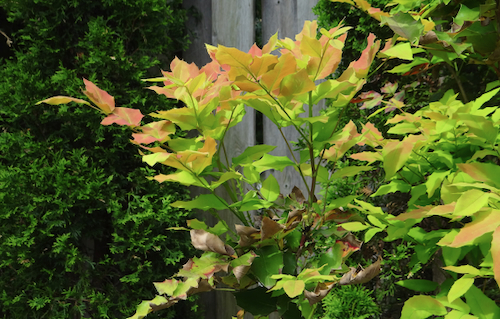
Mahonia x wagneri ‘Pinnacle' - young leaves - Late May.
Fruit: Sour, dark bluish-black berries with thin grey frosting.
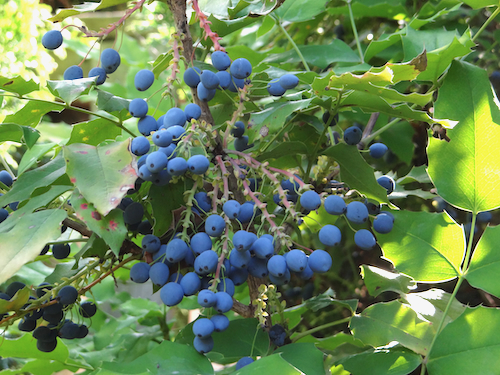
Mahonia x wagneri ‘Pinnacle' - berries - July.
Range: Mahonia aquifolium is native to north and central America.
Habitat: Mixed coniferous woods.
CULTIVATION:
Light: Shade, semi-shade or even full sun with adequate moisture.
Soil: Any good well drained garden soil.
Water: Well drained, moist soil.
USDA Hardiness: Zones 5-8.
Companion planting: In the front of a shrub border or in the back of a rock garden. With spring bulbs.
Propagation: From seed: Expose to fluctuating outdoor winter temperatures with freezing for 3 months. Gradually increase light and temperature in the spring. Pulpy coat inhibits germination. Remove by soaking and rinsing in clean water for approximately 7 days. Discard water and wash off pulpy coat completely in daily detergent washes. Hybrids will not breed true from seed. From cuttings: Semi-ripe in late summer. Division of suckers.
Pruning: Cut back or thin as necessary after flowering.
Pests and diseases: Deer and rabbit resistant. Usually trouble free. Mildew and rusts might occur.
References:
https://onrockgarden.com/index.php/germination-guide
Text and images supplied by Anna Leggatt (Toronto Master Gardener)

Plant of the Month December 2023
GENERAL INFORMATION:
Our ancestors, long ago, believed each plant contained a spirit (this belief is still held by some). When the leaves fell, harmful spirits were free to roam around. Evergreens still had their spirits and were protective so people planted these round their dwellings, or used them as barriers at openings (doors, windows, chimneys, etc.)
Arum italicum has large green marbled leaves that persist all winter, springing upright after being flattened by each dump of snow. Obviously it contains a helpful spirit. Perhaps that is why, subconsciously, I grow it by my front door. (Actually, it is so I can see green in winter.)
Synonym: Arum italicum ‘Pictum’, Arum italicum var. pictum, Arum italicum marmoratum.
Common Name: Italian Arum, Italian Lords and Ladies.
Cultivars and species: Arum italicum ssp. albispathum - with dark green leaves, ‘Chui’ green and cream with black spots (Leopard), ‘Idris’ - green specks on cream, Arum italicum ssp. italicum ‘Gold Rush’ - gold marbling, fading to cream, ‘McClements’ - bright white veins, black spots, ‘Winter White’ larger, leaves appearing in September. Many more variants.
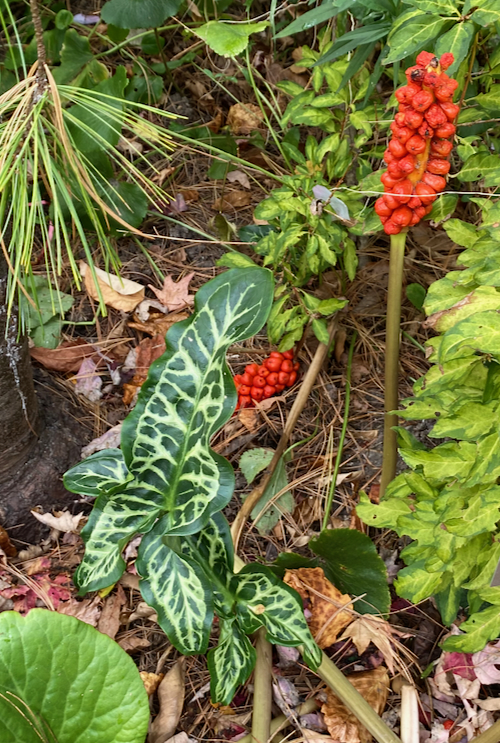
Arum italicum 'Winter White' Mid October.
Life Cycle: Perennial tuber with winter evergreen leaves. Summer dormant.
Height: to 35 cm.
Bloom Time: June.
Leaves: Large 25 cm long, arrow-shaped, shiny dark green leaves, marbled with wide creamy white veins. These start to appear in mid November in Toronto, looking healthy till the end of the following June. The leaves may die in cold exposed areas. More leaves appear in the late winter.
Arum italicum 'Marmoratum' - Nov. Arum italicum 'Marmoratum' - Late Dec.


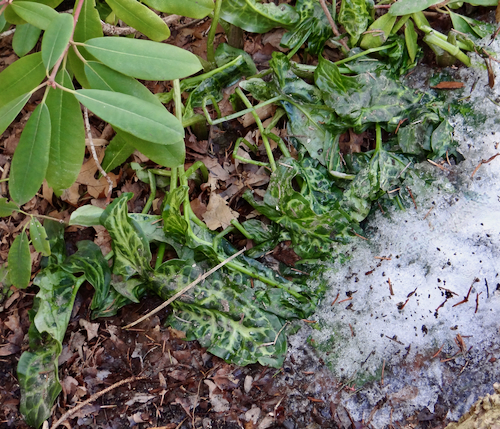
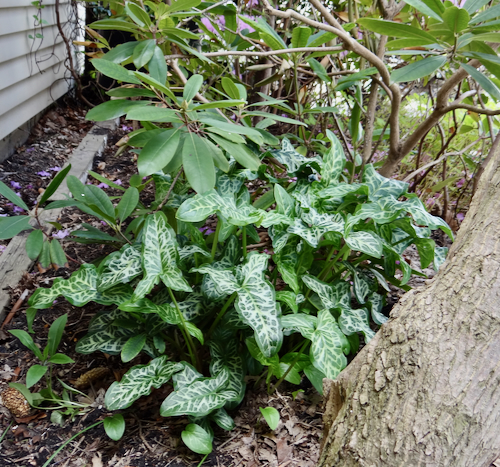
Arum italicum 'Marmoratum' - March. Arum italicum 'Marmoratum' - May.
Flower Colour & Size: Large creamy green spathes with tiny flowers on a yellow spadix.
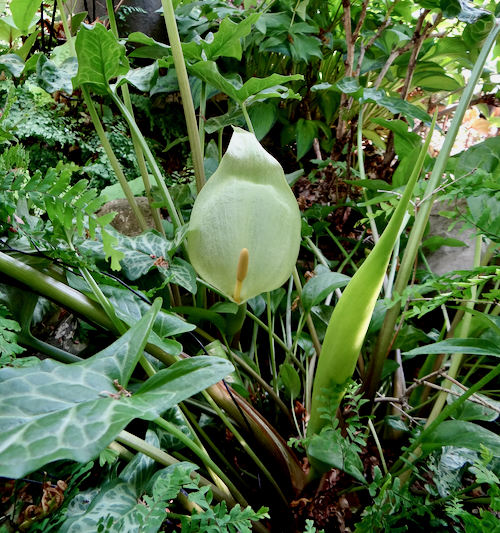
Arum italicum 'Marmoratum' Inflorescence and bud.
Fruit: Attractive spike of reddish orange berries in the fall. Each berry contains several seeds.
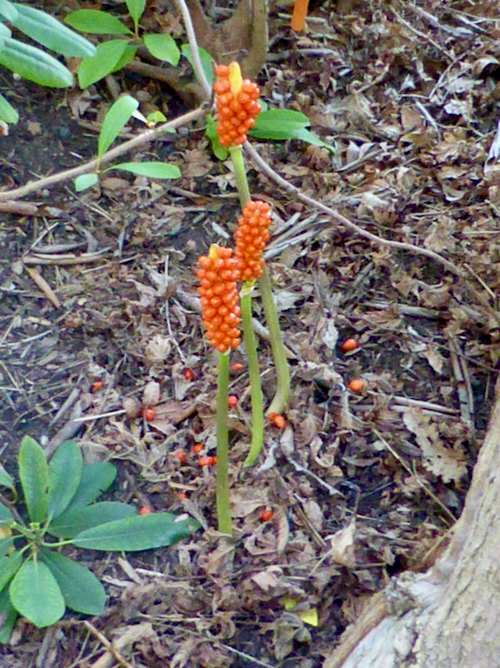
Arum italicum 'Marmoratum' Berries, September.
Range: Native to Mediterranean.
Habitat: Woody areas.
CULTIVATION:
Plant: tubers 10-15 cm deep.
Light: Partial to full shade.
Soil: Most soils, preferably with plenty of organic material.
Water: Moist, well drained, but will tolerate dry soil.
USDA Hardiness: Zones 5-9b.
Companion planting: Other shade garden plants, under shrubs, woodland garden.
Propagation: Divide after flowering and replant. Seeds: Sow immediately outside. Stored seed might be coaxed into germination with temperature cycling and patience. Use repeated cycles of 20°C, then 4°C for 3 months each. Germination is very prolonged. Requires darkness and soaking. Place in warm water until seeds swell, usually 24-48 hours. Discard water and anyfloating seeds. Store seeds @ 6°C; grow seedlings at cool temperature till true leaf appears.
Problems: Poisonous and can be invasive. Usually pest and disease free.
References:
https://www.rhs.org.uk/plants/92886/arum-italicum-subsp-italicum-marmoratum/details
https://www.missouribotanicalgarden.org/PlantFinder
https://www.pacificbulbsociety.org/pbswiki/index.php/arum
https://www.cotswoldgardenflowers.co.uk/?s=Arum+italicum&asp_
https://onrockgarden.com/index.php/germination-guide
Text and images supplied by Anna Leggatt (Toronto Master Gardener)

Plant of the Month November 2023
GENERAL INFORMATION:
Now is the time to think about seed orders. With an early start, many biennials and perennials will flower in their first year.
Foxgloves are one of my favourites. As a child, I loved putting the large pink bells of Digitalis purpurea on my fingers. (“Fingerhut” - Lady’s Glove in Germany). We saw plants in the wild on visits to the south and west of Stratford-on-Avon near where I grew up. (Shakespeare does not mention foxgloves, indicating he really wrote the plays as other possible authors would have seen many in their neighbourhoods.)
I have observed D. purpurea growing in the wild and naturalized in North America, New Zealand, etc. I found D. lanata growing in Greece and surprisingly naturalized in our small local ravine system here in Toronto. D. grandiflora was growing at woodland edges on lower slopes of the French Alps. D. thapsi is Spanish. We saw patches growing in stoney ground in full sun.
The genera, Digitalis and Penstemon, are now in the Plantaginaceae, no longer in the large family of Scrophulariaceae. Linnaeus reputedly dumped several groups in this family as their differences were minor!
The medical use of digitalis was popularized by a Birmingham, UK, doctor, William Withering, whose book, 'An Account of the Foxglove', was first published in 1785. He treated patients with foxglove leaves for dropsy, but noticed their effect on the heart. He ended with saying that foxgloves might produce a valuable heart drug in the future. Digoxin, extracted from Digitalis lanata was very important but is now mostly synthetic.
Synonym: Digitalis 'Café Crème’, a name used for marketing.
Common Name: Woolly foxglove or Grecian foxglove.
Life Cycle: Herbaceous biennial or short-lived perennial.

Digitalis lanata.
Bloom Time: June - July, with more flowers into August if the spent stem is removed above any leaves.
Height: Flowering stem 60 - 75 cm.
Leaves: Low evergreen rosette for the first year with numerous, mid-green, stalkless leaves. These are lanceolate, up to 15 cm long, 2-3 cm wide with 3-4 parallel veins. The leaves are supposedly hairy at the base and undersides. My plants do not show this. 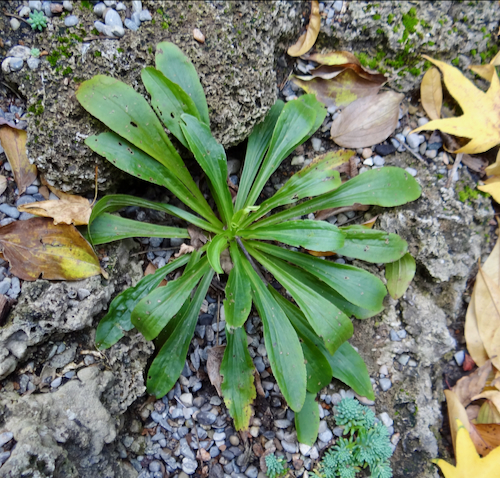
Digitalis lanata - winter leaves.
Flower Colour & Size: Many 2.5 cm long, tubular to bell-shaped flowers are densely packed on a leafy, wooly (lanata) stalk. The sepals and the outside of the corolla are hairy. The tubes are white, with honey-brown reticulate netted veins on the inside. The lower central lobe forms a white tongue, sticking out about 1 cm. 4 stamens are clustered above this at the tube entrance.
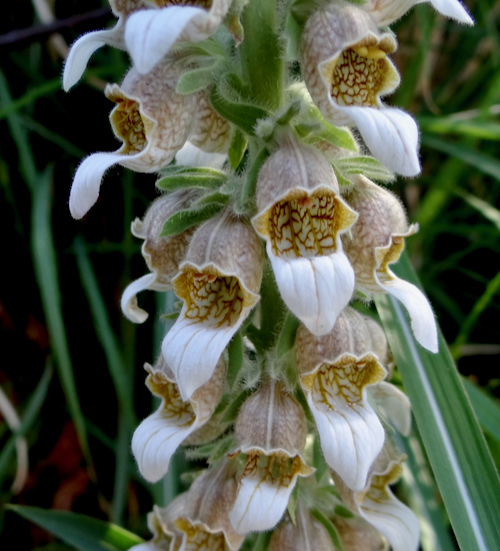 Digitalis lanata - inflorescence.
Digitalis lanata - inflorescence.
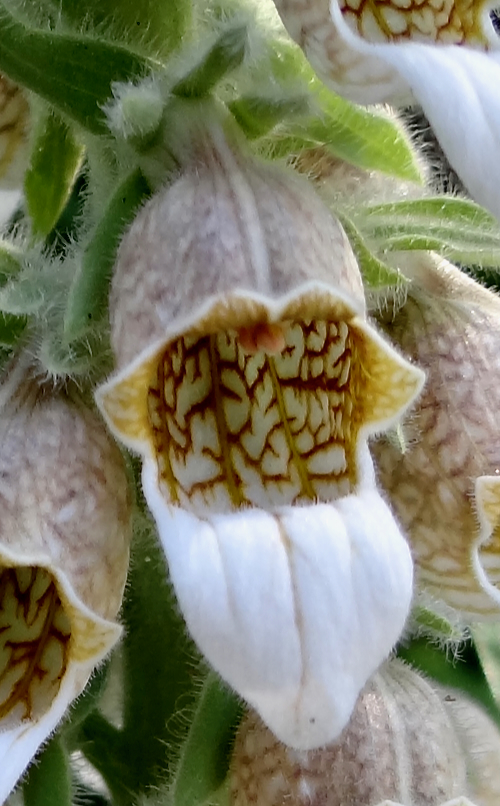
Digitalis lanata - close up of flower.
Fruit: 2-chambered, pointed, conical capsule about 1 cm long, with numerous seeds.

Digitalis lanata - capsules with seeds.
Range: Native to Eastern Europe to Turkey. Naturalized in other parts of the world. Invasive in some parts of the US.
Habitat: Grasslands and woodland edges.
CULTIVATION:
Light: Half shade to full sun.
Soil: Most soils - prefers neutral to acid with plenty of organic material.
Water: Average. Withstands drought when well established.
USDA Hardiness: Zones 4-9.
Companion planting: Woodland edge plants. N.B. may hybridize with other Digitalis.
Propagation: Will self-seed. Starting indoors, sow @ 20°C in light. Seed will germinate within 3 months. Basal offshoots can be removed and rooted.
Problems: All parts toxic. Crown and root rot can occur if the plant is waterlogged.
References:
https://onrockgarden.com/index.php/germination-guide
https://en.wikipedia.org › wiki › Digitalis_lanata
https://www.minnesotawildflowers.info/flower/grecian-foxglove
William Withering, An Account of the Foxglove, 1785.
Text and images supplied by Anna Leggatt (Toronto Master Gardener)

Plant of the Month October 2023
GENERAL INFORMATION: I like all the shapes and bright colours of the multitude of Tulip flowers. However, many of these gorgeous cultivars are short lived in my garden. They are perhaps at their best massed in formal beds or in large groups in a spring bed.
I discovered species tulips and their cultivars. These are shorter and live much longer. One of my clumps must be 30 years old but only slowly increasing in a somewhat difficult area. Others self seed and appear in different places.
Synonym: Tulipa batalini ‘Bright Gem’, Tulipa ‘Bright Gem’
Common Name: Species Tulip. Botanical Tulip.
Cultivars: Tulipa linifolia (Batalinii Group) 'Honky Tonk’, 'Red Hunter' (red), ‘Bronze Charm’, ’Apricot Jewel', 'Yellow Jewel’.
Life Cycle: Perennial bulb.
Height: 10-25cm, spreading to 10 cm.
Bloom Time: Mid May.
Flower Size & Colour: Buds 6 cm long, opening to a 6-pointed star. Soft yellow tepals have apricot centre - more colour in strong light.
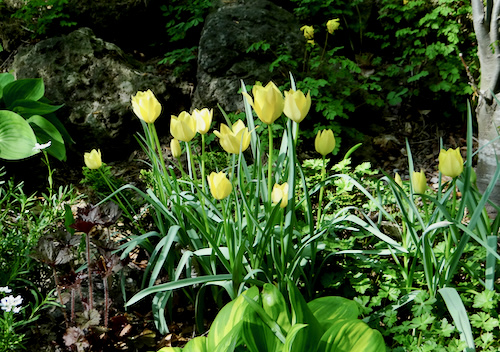
Tulipa linifolia ‘Bright Gem’ - flowers and leaves.
Leaves: Long, grey-green narrow foliage with undulating margins, 20 cm tall.
Range: Native to Uzbekistan.
Habitat: Screes and rocky meadows in mountains.
CULTIVATION:
Plant: Bulbs in groups (10-20 bulbs) in fall up to first light frost, 20 cm deep, 10 cm apart.
Light: Full sun to light shade.
Soil: Most fertile, well drained soils.
Water: Moderate, dry in summer.
USDA Hardiness: Zones 3-8. Needs winter cold.
Companion planting: Dwarf evergreens, small bulbs, other rock garden plants.
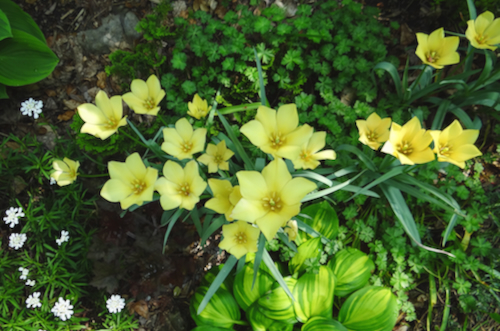
Tulipa linifolia ‘Bright Gem’ with companion plants.
Propagation: From Seed - Expose to fluctuating outdoor winter temperatures including freezing for 3 months. Gradually increase light and temperature in the spring. Grow seedlings at cool temperatures – best achieved by sowing in open ground. Also by division - dig bulbs after leaves die back. Separate and replant, or store in a cool dry place and plant in October.
Problems: Few - rodent and slug damage. Toxic to cats and dogs.
References:
https://www.missouribotanicalgarden.org/PlantFinder
https://www.gardenia.net/plant/tulipa-batalinii-bright-gem-botanical-tulip
https://onrockgarden.com/index.php/germination-guide
Text and images supplied by Anna Leggatt (Toronto Master Gardener)

